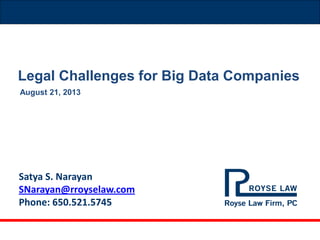
Legal challenges for big data companies
- 1. Satya S. Narayan SNarayan@rroyselaw.com Phone: 650.521.5745 August 21, 2013 Legal Challenges for Big Data Companies
- 2. Volume 12 tb of tweets converted per day Velocity 5 million trade events analyzed per day to detect fraud Variety 100s of live video feeds monitored to target points of interest Veracity Connecting different data points to facilitate decision making BIG DATA “Big Data is a term that describes large volumes of high velocity, complex, and variable data that requires advanced techniques and technologies to enable the capture, storage, distribution, management, and analysis of the information.” - TechAmerican Foundation.
- 3. Data privacy and security Compliance issues Service levels Reliability and other warranties Indemnification and Limitations of Liability Key Legal Concerns
- 4. Personal information “is any information about an individual maintained by an agency, including (1) any information that can be used to distinguish or trace an individual‘s identity, such as name, social security number, date and place of birth, mother‘s maiden name, or biometric records; and (2) any other information that is linked or linkable to an individual, such as medical, educational, financial, and employment information." – National Institute of Standards and Technology Data handling permissions; usage restrictions End user’s permission Fair Credit Reporting Act Consumer’s right to correct personal information Do Not Target v. Do Not Collect debate Is de-identification/ anonymization of data done properly to prevent re- identification Whose privacy policy should apply? Is Customer’s privacy policy too restrictive? What permissions does Customer need to obtain from end users? Data Privacy
- 5. “Reasonable/ appropriate” security measures – not good enough Whose privacy policy and security policy should apply? Customer’s data security questionnaires and data privacy schedules Security audits To what extent should Customer be responsible for data security and privacy issues? Who bears the risk of a “no-fault” breach? Data Security
- 6. Costs of Data Security Breaches
- 7. Data security related potential costs; can these costs be shared? Data security breach costs Notification related costs Support costs (e.g., help desk and credit monitoring services) Fines and litigation Security audit costs SSAE (16) Type II Audit Enterprise customers, particularly publicly traded customers, will often ask for this audit if Provider performs outsourced services that affect the customer’s financial statements $20,000 – $50,000 (depending on type of business, number of locations, number of employees, number of applications, and deadline for completion) Implementation costs of new security measures Data Security
- 8. What is the Provider’s role in data-related compliance? Data privacy and security E-discovery and document preservation Regulatory compliance in specific industries (for example, pharma and automotive industries; banking and financial industry) Compliance issues
- 9. What performance guarantees should a Provider give? Uptime, throughput, mean-time-to-restore, latency, and bandwidth guarantees Customer may ask for warranties Criticality of service to Customer’s end-user interactions Limitations/ exclusions (for example, Provider’s hosting provider’s failures) Remedies Service credits; fixing the issue; contract termination Are your remedies exclusive? Is payment of service credits automatic? Customer duties and responsibilities Service Levels
- 10. Warranties Data accuracy and completeness? Software performance? Warranties implied by law Exclusions Disclaimer Reliability and Other Warranties
- 11. Provider indemnification: Breach of privacy or security? Third-party intellectual property infringement? Customer’s customer issues (for example, from a breach of a service level)? Exclusions Should the Customer indemnify the Provider? Limitations on Provider’s liability: Consequential damages disclaimer (for example, lost profits of Customer arising from a data security breach) Caps on liability Exclusions from liability limitations Insurance Indemnification & Limitations of Liability
- 12. Post-termination transition/ migration assistance Return of Customer data Source code/technology escrow Business continuity/exit plans Change of control consent/ notice Additional Customer Asks
- 13. As a Provider, pay close attention to: obtaining adequate data permissions proper de-identification/ anonymization of data specifying a uniform security standard specifying uniform service levels and remedies assessing risks and developing a playbook for warranty, indemnity, and liability negotiations; identify your maximum risk undertaking threshold obtain adequate insurance watch for new FTC and privacy legislation and guidance Concluding Comments
- 14. PALO ALTO 1717 Embarcadero Road Palo Alto, CA 94303 LOS ANGELES 11150 Santa Monica Blvd., Suite 1200 Los Angeles, CA 90025 SAN FRANCISCO 135 Main Street, 12th Floor San Francisco, CA 94105 Satya S. Narayan SNarayan@rroyselaw.com Phone: 650.521.5745 Royse Law Practice Areas Corporate Securities Tax Mergers & Acquisitions Fund Services Intellectual Property Technology Transactions Labor & Employment Immigration Litigation Estate, Trust & Wealth Strategy Real Estate International
